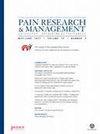他莫昔芬与腰椎间盘退变的相关性分析:一项回顾性病例对照研究
IF 2.5
3区 医学
Q2 CLINICAL NEUROLOGY
引用次数: 0
摘要
目的探讨他莫昔芬(TAM)与腰椎间盘退变(IVDD)的相关性。方法对2015年1月至2020年12月我院脊柱外科收治的患者进行回顾性分析。研究人员确定了有乳腺癌手术史的患者,并收集了他们的数据。这些资料包括患者的年龄、体重指数(BMI)、月经史、术后史、药物治疗方案、影像学资料。参与者被分为TAM组和非TAM组。腰椎IVDD通过腰椎前凸度(LL)、椎体CT密度、腰椎间盘高度指数(DHI)、Modic变化和修正Pfirrmann分级评分进行评估。采用SPSS 20进行统计分析。结果本研究共纳入75例患者,TAM组46例,非TAM组29例。两组患者的年龄、BMI、术后病史、LL、椎体CT密度均无显著差异。TAM组L1/2和L2/3的DHI较非TAM组低(P=0.038和P=0.034),而L3/4、L4/5和L5/S1的DHI及TAM组与非TAM组的平均DHI比较无统计学意义。TAM组L1/2和L2/3 ivd的改良Pfirrmann评分高于非TAM组(P=0.004和P=0.025)。两组间L3/4、L4/5、L5/S1比较无统计学意义。关于Modic变化发生的比较在TAM组和非TAM组之间没有显着差异。结论本研究提示TAM使用与腰椎IVDD可能存在正相关。特别是,L1/2和L2/3的退化与TAM的使用有关。本文章由计算机程序翻译,如有差异,请以英文原文为准。
Correlation Analysis between Tamoxifen and Lumbar Intervertebral Disc Degeneration: A Retrospective Case-Control Study
Objectives To investigate the correlation between tamoxifen (TAM) and lumbar intervertebral disc (IVD) degeneration (IVDD). Methods The patients who visited the department of spine surgery from January 2015 to December 2020 were retrospectively reviewed. Those with a history of breast cancer surgery were identified and their data were collected. These data included patients' age, body mass index (BMI), menstrual history, postoperative history, drug treatment plan, and imaging data. The participants were divided into the TAM group and the non-TAM group. Lumbar IVDD was assessed by lumbar lordosis (LL), vertebral CT density, lumbar disc height index (DHI), Modic changes, and modified Pfirrmann grading score. SPSS 20 was used for statistical analysis. Results A total of 75 patients were included in this study, 46 patients in the TAM group and 29 patients in the non-TAM group. No significant differences were present in age, BMI, postoperative history, LL, and vertebral CT density between the two groups. The DHI of L1/2 and L2/3 in the TAM group was lower compared to the non-TAM group (P=0.038 and P=0.034, respectively), while comparisons regarding the DHI of L3/4, L4/5, and L5/S1, and the average DHI between TAM and non-TAM groups were not significant. The modified Pfirrmann grading scores of the L1/2 and L2/3 IVDs in the TAM group were higher than those in the non-TAM group (P=0.004 and P=0.025, respectively). Comparisons of L3/4, L4/5, and L5/S1 between the two groups were not significant. The comparisons regarding the occurrence of Modic changes did not show a significant difference between the TAM and non-TAM groups. Conclusions This study indicates that there might be some positive correlation between TAM use and lumbar IVDD. In particular, the degeneration of L1/2 and L2/3 has shown a correlation with TAM use.
求助全文
通过发布文献求助,成功后即可免费获取论文全文。
去求助
来源期刊

Pain Research & Management
CLINICAL NEUROLOGY-
CiteScore
5.30
自引率
0.00%
发文量
109
审稿时长
>12 weeks
期刊介绍:
Pain Research and Management is a peer-reviewed, Open Access journal that publishes original research articles, review articles, and clinical studies in all areas of pain management.
The most recent Impact Factor for Pain Research and Management is 1.685 according to the 2015 Journal Citation Reports released by Thomson Reuters in 2016.
 求助内容:
求助内容: 应助结果提醒方式:
应助结果提醒方式:


